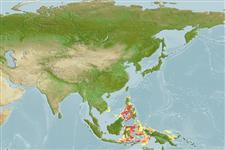Actinopterygii (ray-finned fishes) >
Notacanthiformes (Halosaurs and deep-sea spiny eels) >
Halosauridae (Halosaurs)
Etymology: Halosaurus: Greek, als, alis = salt + Greek, sauros = lizard (Ref. 45335).
Environment / Climate / Range
Ecology
Marine; bathydemersal; depth range ? - 706 m (Ref. 280). Deep-water, preferred ?
Western Central Pacific.
Size / Weight / Age
Maturity: Lm ? range ? - ? cm
Bottom feeders; mainly on crustaceans and other small invertebrates. Males with markedly enlarged olfactory organs at maturity. Leptocephalus larvae pelagic. Taken occasionally in deep bottom trawls (Ref. 12887).
Life cycle and mating behavior
Maturity | Reproduction | Spawning | Eggs | Fecundity | Larvae
Smith, D.G., 1999. Halosauridae. Halosaurus. p. 1625-1626. In K.E. Carpenter and V.H. Niem (eds.) FAO species identification guide for fishery purposes. The living marine resources of the WCP. Vol. 3. Batoid fishes, chimaeras and bony fishes part 1 (Elopidae to Linophrynidae). FAO, Rome. (Ref. 12887)
IUCN Red List Status (Ref. 115185)
CITES (Ref. 94142)
Not Evaluated
Threat to humans
Harmless
Human uses
Fisheries: of no interest
More information
Common namesSynonymsMetabolismPredatorsEcotoxicologyReproductionMaturitySpawningFecundityEggsEgg development
Age/Size
Growth
Length-weight
Length-length
Length-frequencies
Morphometrics
Morphology
Larvae
Larval dynamics
Recruitment
Abundance
ReferencesAquacultureAquaculture profileStrainsGeneticsAllele frequenciesHeritabilityDiseasesProcessingMass conversion
Tools
Special reports
Download XML
Internet sources
